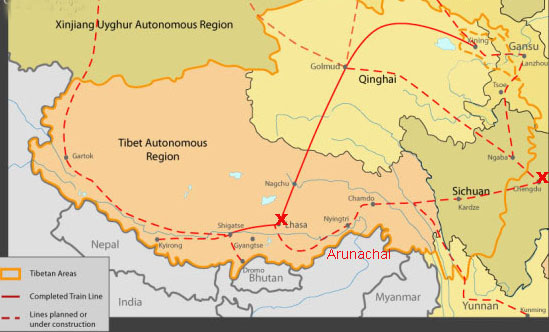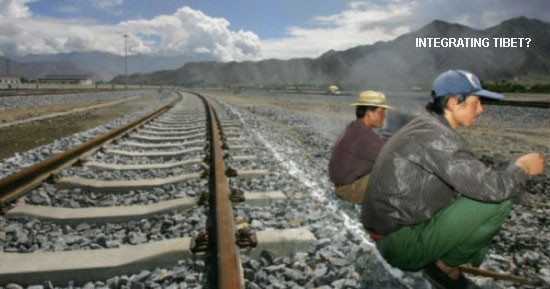March 23, 2016
BEIJING: China is expediting the construction of a second, new railway line from
Lhasa, the Capital of the Tibetan Autonomous Region, to Chengdu, the capital of
Sichuan province, to the east, running parallel and close to India's northern
borders, with one western extension to Kyirong on its Nepal border and another
branch to Bhutan border.

The new railway line will reduce travel time from Chengdu to Lhasa from 42 hours
to 15 hours by train. It is said to become one of the most difficult rail lines to
have been built in the whole world, and is now scheduled to be completed by
2020.
The projects okayed by the Chinese National People’s Congress which met this
month also included the extension of the Qinghai-Tibet Railway from Shigatse
(Chinese: Rigaze) to Kyirong (Chinese: Gyirong) on the Nepal border.
The extension towards Nepal is likely to have tunnels passing through the Mount
Everest area. It will connect Lhasa and Shigatse with Kyirong on the Nepal border,
and Yatung (Dromo in Tibetan) in the Tibet area near Bhutan border. These have
strategic implications for India. However, Nepal has welcomed the new ‘land port’
at Kyirong.
Apart from international security issues, the Chengdu route especially passes
through certain sensitive areas where crackdown on Tibetan demonstrations are
frequent. Once done, it helps quick transportation of soldiers to Tibet.
The region is also environmentally sensitive as the high-altitude landscape is
warming up fast.
The impact of the new railway from Chengdu to Lhasa might “far surpass” that of
the Qinghai-Lhasa line which was opened in 2006. The new railway will further
help exploit the vast natural resources and at the same time help Beijing
consolidate its grip over the Tibetan region. Such interference might as well pose
danger to water supplies across the Asian region.
China’s rubber-stamp Parliament, called National People’s Congress, opened its
annual session at the Great Hall of the People in Beijing on March 5. The Chinese
Communist Party holds two plenary meetings, one for its legislators, the National
People’s Congress (NPC), and the other for its chief political advisory body, the
Chinese People’s Political Consultative Conference (CPPCC). They prepare the
agenda for the Government.

“In environmental, demographic and cultural terms, the impact of this new railway
on Tibet’s landscape and Tibetan lives is likely to be even more significant than
the link from Golmud in Qinghai to Lhasa, which opened in 2006. (The length of
the Xining-Golmud-Lhasa railway is 1,956 km. The 815 km section between
Xining and Golmud was completed in 1984 and the 1,141 km section between
Golmud and Lhasa was completed in 2006). Traversing an area that is rich in
forests and mineral resources, it will facilitate further large-scale exploitation of
Tibet’s natural resources as well as enabling greater population migration into
Tibet, both seasonal in terms of tourists and migrants, and permanent settlers,”
said Matteo Mecacci, president of the International Campaign for Tibet. On the
other hand, Lobsang Gyaltsen, chairman of the Tibet Autonomous Region
government, said the route is vital for them.
According to Washington-based International Campaign for Tibet (ICT), China’s
infrastructure plan in Tibet will boost tourism, exploitation of Tibet’s resources
and provide strategic support for military objectives.
“This (new line) is close to the sensitive area of Arunachal Pradesh in India, which
China claims as part of the PRC, which has created alarm in India with
implications for regional security being raised by commentators in India and South
Asia,’’ the ICT statement said.
It will also enable greater population migration into Tibet being encouraged to
drastically morphing the rebel, ethnic Tibetan demography.
- RM Nair